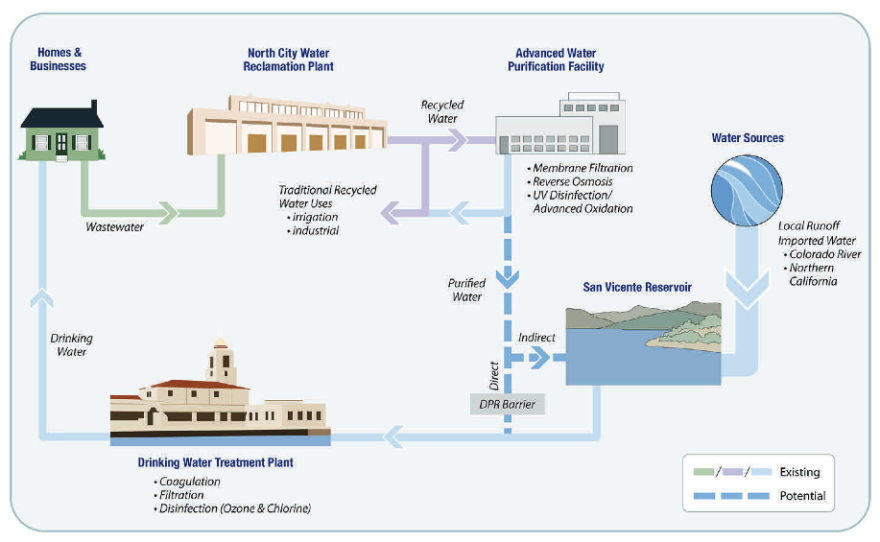The San Diego City Council votes Tuesday on whether to generate more recycled water for thirsty residents in exchange for giving a "pass" to the city's sewage plant, which has never met federal Clean Water Act standards.
The Point Loma Wastewater Treatment Plant is the heart of the region's sewage system, now pumping about 180 million gallons of sewage a day. It started out small in 1963, wedged onto a clifftop in Point Loma. Supervisor David Huntamer said the plant has expanded to keep up with demand. "We've added more digesters," Huntamer said. "We've added the bio-solids holding tank. We've added several more sedimentation basins. We're adding a new grit system. So we're constantly doing that. And we're also fine-tuning our process."
The facility now serves 2.2 million people in 16 municipalities. Sewage is treated, then discharged offshore through a four-mile long underwater pipe. Over the years, improvements at the plant have used up every bit of available space.
Even with all the improvements, the facility falls short of clean water standards that every other sewage plant in the United States meets. "It is the only plant in the United States that doesn't meet secondary standards," said Ann Sasaki, an Assistant Director in the San Diego Public Utilities Department. "However, I want to make it clear that the city of San Diego and this Point Loma plant are meeting all the regulations of the Clean Water Act."
That is because EPA waivers allow the San Diego plant to operate under special rules. Clean Water Act rules require treated effluent to meet three benchmarks. Sasaki said San Diego's effluent meets one of the three: PH requirements.
"We're very close to meeting secondary standards for total suspended solids," Sasaki said. "But we don't meet the BOD standards."
BOD stands for biochemical oxygen demand. San Diego's problem has always been that there's no room at Point Loma to build the the expensive aeration ponds that would put back the oxygen that the other sewage treatments take out.
But city officials have long argued the standard shouldn't apply here.
"When the Clean Water Act was written, it was written as a one-size-fits-all, for treatment plants that discharged into rivers, or streams or bays. They have the same requirements, and in reality, sometimes one-size-fits-all doesn't work," Sasaki said.
Years of mandated monitoring by the Scripps Institution of Oceanography prove there's no harm to the environment, according to Sasaki.
The city was not excited about the possibility of spending $2 billion to put oxygen into sewage that is just going to be dumped into the ocean. Instead, the city, business groups, and environmentalists decided to pour the money into a ground-breaking water recycling project.
San Diego Mayor Kevin Faulconer is urging city leaders to approve the Pure Water Plan. He said the drought puts things in perspective.
"It is the right thing to do from a water independence standpoint," Faulconer said. "The right thing to do for our environment so less is going out to the Point Loma Outfall. Probably most important, it gives us certainty."
Certainty that comes in the form of a drought-proof water supply. The deal would modify the Point Loma discharge permit so a waiver is no longer needed. In exchange, the city agrees to create 50 million gallons a day of potable water by 2023, and 83 million gallons a day by 2035.
Ann Sasaki said that would be done by diverting as much as half of the sewage before it even reaches the Point Loma sewage plant. Three new treatment plants would clean the water multiple times before being distributed to homes.

The idea gained a foothold back in 2010, when the city agreed to do a water recycling study. That was one condition for the last five-year waiver from the EPA. San Diego Waterkeeper Matt O'Malley said the study found the diversion plan could work and it kick-started talks about the innovative solution to the city's sewage problem.
He said the drought added an exclamation point.

"Especially in the drought. People realize how serious this is. With climate change coming about, we're going to see longer droughts, more frequent droughts. So we need a water source. And there are very few options out there," O'Malley said.
The city is committing to recycling 83 million gallons of water a day, but O'Malley thinks they will do more once they see how well it works. And the environmental community will remain vigilant, making sure the city keeps its promises.
"It's important for people to know that in this agreement, we give up no rights to enforce the Clean Water Act," O'Malley said. "If there's any degradation of the environment, we have the right to enforce, and we will do that if we need to."
Federal officials have been briefed and they are inclined to listen. Jared Blumenfeld is the Region 9 EPA administrator and he said the plan could be good for the city and the ocean.
"We want to give the city regulatory flexibility to come up with a plan where they can get more water in this time of drought. That's pretty important," Blumenfeld said. "So anything that isn't going to that facility, that can be shaved off and used as either greywater, even drinking water, is something that we're going to look favorably towards."
But before the EPA can make a decision, the San Diego City Council has to consider the idea when it votes on Tuesday.






